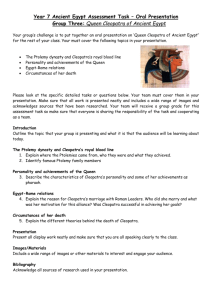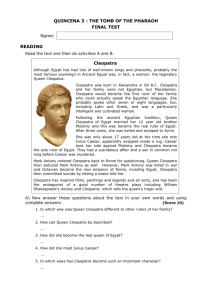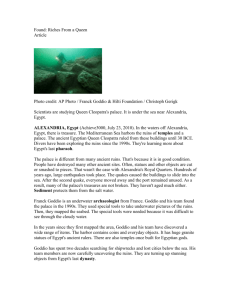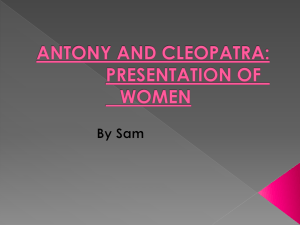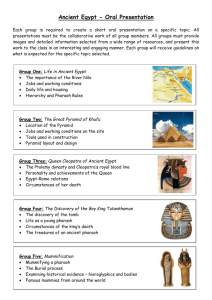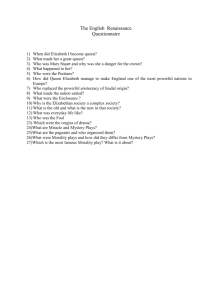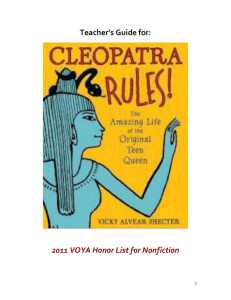Semester 2 Paper.doc
advertisement
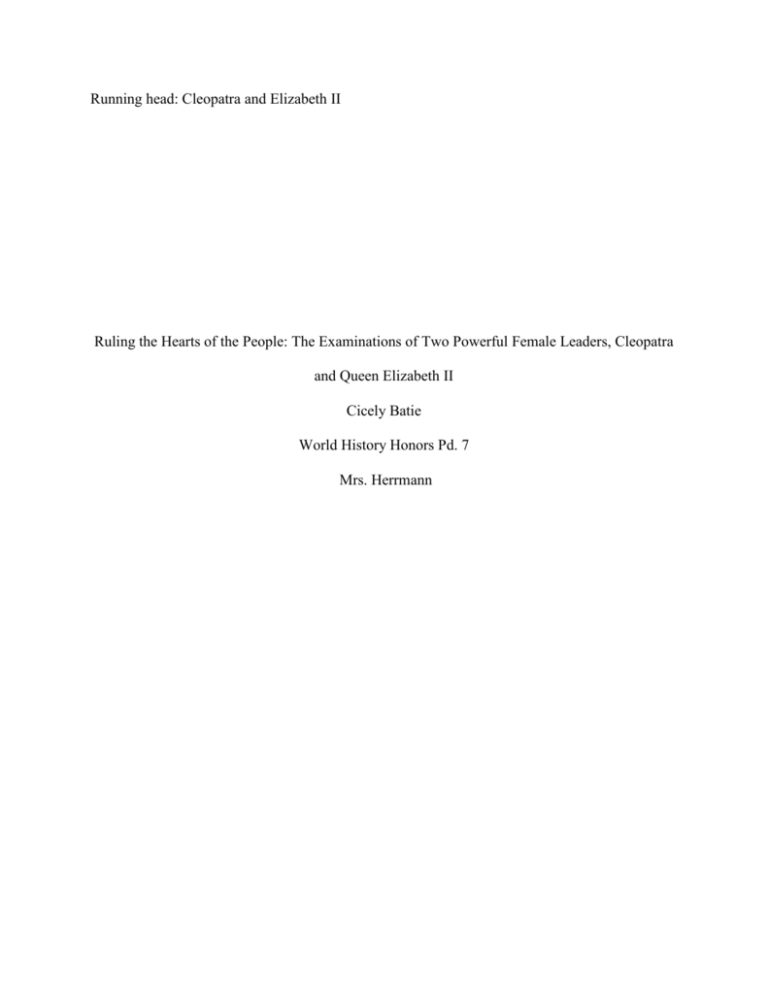
Running head: Cleopatra and Elizabeth II Ruling the Hearts of the People: The Examinations of Two Powerful Female Leaders, Cleopatra and Queen Elizabeth II Cicely Batie World History Honors Pd. 7 Mrs. Herrmann Cleopatra and Elizabeth II 2 Ruling the Hearts of the People: The Examinations of Two Powerful Female Leaders, Cleopatra and Queen Elizabeth II Since early-recorded history, there has been a constant struggle between the sexes, between the obvious stronger power of men and the freewill of women. Female leaders throughout the centuries have been powerful and influential, but at the same time overruled by their male counterparts and not trusted as willingly by their people had they been men. This can be found in the story of Cleopatra, Queen of Egypt in ancient times, as well as the tale from modern history of Elizabeth II, Queen of England. Their lives can be compared based on the struggles they faced with leading powerful countries, but contrasted as well by the era of history in which their stories unravel. Cleopatra and Queen Elizabeth’s lives make interesting biographies worth comparing and contrasting. Cleopatra was born around the year 69 BC in the great port of Alexandria, Egypt. Her father was ruler over Egypt and a descendent in the Ptolemaic dynasty in which Cleopatra would be the last ruler. A common misconception is that she was Egyptian, but she was not by blood. The Polemic’s came from Greece near Macedonia, they over took Egypt and began ruling Egypt (BBC, 2010) After the death of her father when she was 18, as stated in his will, Cleopatra became the pharaoh of Egypt. However, being a woman she was not allowed to rule alone and was forced to marry her younger brother, who was 12, in order to rule (Bevan, 1927). She made it very clear from early on that she did not wish to share power. This made many of the other leaders very unhappy and soon Cleopatra found herself in exile. During this time Julius Caesar took over Egypt. Cleopatra moved to align herself with Caesar hoping that she could regain power. Some stories say that she had herself rolled up in a Cleopatra and Elizabeth II 3 rug and smuggled into his chamber, the two then became lovers and Cleopatra gave birth to Julius Caesars’ son, whom she named Ptolemy Caesar or Caesarion. Julius Caesar was able to reinstate Cleopatra as ruler of Egypt provided that her son, Caesarion, could be named her coruler because he was male (Bevan, 1927). However, political relations in Rome were changing and Caesar was assonated, which of coarse ended his and Cleopatra’s affairs and also left Egypt once again vulnerable to its powerful Roman neighbors. She sided with Mark Antony and Octavian in the Roman Civil war (BBC, 2010). Mark Antony and Cleopatra also had an affair which resulted in her giving birth to twins. Mark Antony then married Cleopatra in a traditional Egyptian ceremony where they traveled down the Nile to a sacred temple and were wed with Cleopatra’s three children present. All three were named future rulers of Egypt (One, 2005). Octavian was not happy about this because Mark Antony married his younger sister, so they went to war. Mark Antony was defeated by Rome’s superior military, and he is killed. There are many speculations about why Cleopatra committed suicide, but all texts agree that she did in fact kill herself. A popular theory is that she allowed an asp, a poisonous cobra, to bite her arm. She, as well as two of her handmaids, died with her (Bevan, 1927). Ceaserion was named pharaoh of Egypt, but was killed by Octavian’s forces. Cleopatra’s children with Antony were taken back to Rome and cared for by his first wife, Octavian’s sister (One, 2005). The death of Cleopatra was an end of an era of pharaohs, as Egypt would never be ruled by one again as it became a Roman province. Cleopatra is remembered as one of history’s most fascinating characters, and is recorded in countless books, plays and movies. The Egyptian people loved her because she took the time to understand Egyptian culture whereas none of the Greek pharaohs did. She learned how to read hieroglyphics and learned how to speak the Cleopatra and Elizabeth II 4 language. She took on the symbolic nature of their goddess, Isis. She was not extraordinarily beautiful as portrayed in popular dramas, but instead was able to charm several Roman leaders with her wit and intelligence. During her reign she was able to keep good relations with Rome but not allow them to completely control Egypt, which is fairly impressive compared to many other nations that were just conquered by the Romans. She was indeed a powerful leader and always had the intentions of her people in mind. The baby girl who was to become Queen Elizabeth II was born April 21, 1926. She was the first child of Prince Albert and wife, Elizabeth (Report, 2001). When she was born, it was never thought that she would succeed to the throne. She was third in line behind her father and uncle, who was first in line. When her grandfather, King George V, died, her uncle, Edward, inherited the throne. However, Edward fell in love with Wallis Simpson, a widowed American actress, and this raised much controversy when they announced their engagement. The British did not want this American divorcee to become their queen, so without even reigning a full year as King of England, Edward abdicated the throne in order to marry Wallis Simpson (Britroyals, 2010). Our tour guide in London this summer said that it was one of the world’s truly great love stories. With her uncle’s abdication, Elizabeth now became the heiress presumptive and her education to prepare for her future job changed as well. Several tutors at home taught her and her sister and Elizabeth’s education was steeped in English history, and study of the Constitution and government. She was a willing learner and worked hard at her studies (NNDB, 2010). At age 21 Elizabeth married Philip Duke of Edinburgh, he was a part of the Greek royal family. The two are actually third cousins through Queen Victoria as she is the great-greatgrandmother of both of them (Report, 2001). They had been sweethearts for many years before Cleopatra and Elizabeth II 5 their engagement was announced. As always there was some controversy when the announcement was made because he had no financial status and he was Greek Orthodox. Before the wedding he denounced his previous Greek titles and converted to Anglicanism. The wedding on November 20, 1947, was the typical huge royal affair with many heads of state on the guest list (NNDB, 2010). Elizabeth and Philip had four children with Prince Charles born in 1948 then Princess Anne in 1950, Prince Andrew in 1960 and Prince Edward in 1964 (Britroyals, 2010). In 1951 the King’s health began to decline and he was unable to attend some events and Elizabeth found herself standing in more and more for the King. She was on a tour of the Commonwealths in 1952 and was in Africa when the news of her father’s death reached her (NNDB, 2010). The official coronation did not take place until 1953, even though she became Queen Elizabeth II at the moment of her father’s death. The coronation was a televised event, which was watched by about 20 million people (Britroyals, 2010). The Queen is the official head of state for England, but because of the Constitutional monarchy, her powers are limited. Mostly she serves a ceremonial role and oversees everything done in Parliament. Most of her time is spent making public appearances and balancing public image (NNDB, 2010). Her reign as Queen has been a time of great change, spanning from just after World War II until present day with advances in technology and developments of world affairs. While on the throne the Great British Empire evolved to the British Commonwealths in which many countries have had a planned independence and are now able to rule themselves. She has been steadfast through many of these changes and has been able to keep peace, as well as peace of mind, for the British people. Queen Elizabeth II is now the oldest monarch in British Cleopatra and Elizabeth II 6 history and if still alive in 2015 will become the longest reigning Queen, beating Queen Victoria (Britroyals, 2010). Cleopatra and Elizabeth were both powerful female leaders. They were and are in charge of great nations that have sway in world politics. Both have made several alliances with other powerful nations to improve their country’s political standings. Neither of them has ruled completely alone though. Cleopatra was always forced to have some kind of male “superior” in order that she retain the throne, which came in the form of her younger brothers, Julius Caesar, Mark Antony and her own son. Elizabeth always has the backing of the entire British Parliament. She cannot make any political decisions without their approval and the entire length of her reign she has also been married so she as well has always had that male guardian or sorts. The difference is that Elizabeth was not required to have one in order to maintain the throne. A small similarity is they both had four children, although under very different circumstances. Another large similarity was their devotion to their people. Both Cleopatra and Elizabeth always tried to make decisions and work for the betterment of their subjects, a type of self less rule. Cleopatra actually used herself in order to maintain good relations with Rome in her affairs with Julius Caesar and Mark Antony. Elizabeth has had to endure public scrutiny over some of her family member’s social lives with the divorces of her sister and three of her children. She has always gone out of her way in order to meet with other heads of state from around the world in order that England stay in good standing. She spends all of her time out in the public meeting her subjects, replying to mail and every night before she goes to bed reads over a summary of that’s day events in Parliament. It is said that the last lights out in Buckingham is often in the Queen’s study . Cleopatra and Elizabeth II 7 Even though there are many comparisons between the two queens, there are several distinct differences. A large difference is the era of history in which they ruled. Cleopatra held power in roughly 50 B.C., a time period of slow communication and much of Egypt would not know of the Queen’s affairs or understand the delicate balance of their countries political alliances. The powerful could do almost anything they wanted because usually their subjects would not find out about it until much later or never at all. Queen Elizabeth, on the other hand, is on the throne during a very technologically advanced age where anyone can find out in seconds what is going on in Buckingham Palace. The Queen has to walk a very thin line and mind her P’s and Q’s in order to maintain public favor. She could not have affairs with other world leaders in order to put England ahead because it wouldn’t be acceptable in today’s society and the whole world could find out very soon via the Internet and she would be forced out of a job by the people. There are also different value systems between now and 50 B.C.. Much of the British Commonwealth is Christian and in Egypt they worshiped the gods and goddess of the Ancient Egyptians. This may have been the reason Cleopatra was able to get away with everything she did. Overall I believe that Cleopatra had the most impact on history. Her powerful will and scandalous affairs led to Egypt retaining its independence from Rome during her reign. She is also still remembered in movies, books and plays and most people at least know that she was a Pharaoh of Egypt, even though she died over 2,000 years ago. She will forever be a prominent woman of history and remember for hundreds of years to come. (Bevan, 1927) Cleopatra and Elizabeth II 8 Works Cited BBC. (2010). Cleopatra (c.69 BC - 30 BC). Retrieved January 10, 2010 , from Historic Figures: http://www.bbc.co.uk/history/historic_figures/cleopatra.shtml Bevan, E. (1927). CHAPTER XIII . Retrieved January 10, 2010, from The House of Ptolemy : http://penelope.uchicago.edu/Thayer/E/Gazetteer/Places/Africa/Egypt/_Texts/BEVHOP/13*.htm l Britroyals. (2010). Queen Elizabeth II. Retrieved January 11, 2010, from Royal Family History: http://www.britroyals.com/kings.asp?id=elizabeth2 NNDB. (2010). Queen Elizabeth II. Retrieved January 11, 2010, from NNDB Tracking the Entire World: http://www.nndb.com/people/174/000023105/ One, K. T. (2005). Life of Cleopatra. Retrieved January 10, 2010, from King Tut One: http://www.kingtutone.com/queens/cleopatra/ Report, T. R. (2001). Her Majesty Queen Elizabeth II. Retrieved January 11, 2010, from Royal Profiles: http://www.britainexpress.com/royals/queen.htm

